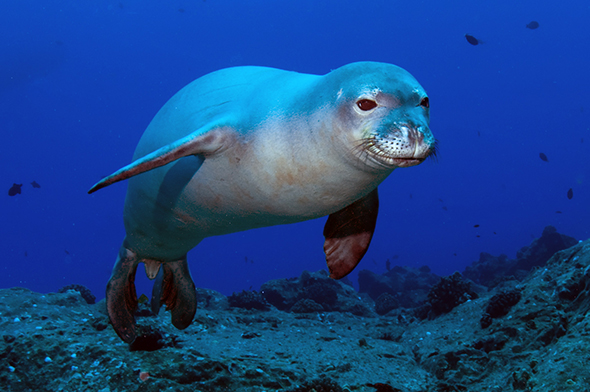 Hawaiian monk seal at Five Fathom Pinnacle, Hawaii. Courtesy of Wikimedia Commons and N3kt0n.
Hawaiian monk seal at Five Fathom Pinnacle, Hawaii. Courtesy of Wikimedia Commons and N3kt0n.
The latest “black mark against domestic cats,” explained a headline in yesterday’s Washington Post: “They’re killing Hawaii’s rare monk seals.” As is so often the case, though, in the age of click-bait journalism, the story is considerably more complicated than the misleading headline suggests.
Referring to a recent Associated Press story, reporter Ben Guarino tells us that the Toxoplasma gondii parasite, sometimes spread via cat feces, “has claimed eight monk seals” over the past 15 years. He fails to acknowledge, however, that those eight deaths represent just 4.4 percent of the 183 seals necropsied by researchers over that period. (The parasite was suspected in another two deaths.) [1]
Another important fact Guarino overlooks: the population of monk seals is actually increasing.*
In the sparsely populated Northwestern Hawaiian Islands, where their largest population is found, “recovery interventions have proven successful thus far… and the monk seal decline in the Northwestern Hawaiian Islands has slowed by eight-fold,” [2] while the population in the Main Hawaiian Islands “is currently increasing and moving on a trajectory toward 500 individuals.” [3]
As Charles Littnan, the National Oceanic and Atmospheric Administration’s lead scientist for the agency’s Hawaiian Monk Seal Research Program, explained earlier this year, survival rates bode well for future increases: “These are the highest levels that we’ve seen in decades, and in some places, the highest levels in survival that we’ve seen in 30 years.” [4]
Sound familiar?
The parallels between The Post’s story and the Scientific American piece from earlier this year, declaring “Cat Poop” a threat to Hawaiian geese, are unmistakable. In both cases, little or no attention was paid to other, more prevalent, sources of mortality. And the fact that the populations of both species are increasing—in the very areas of Hawaii where one would expect to find the greatest exposure to T. gondii—was ignored entirely.
All of which feeds into the witch-hunt against outdoor cats, which only impedes conservation efforts. On the other hand: less than 18 hours after Guarino posted his story, 172 comments!
* Curiously, Guarino himself is responsible for the most dramatic increase. “All told,” he writes, “the seal population is just over one thousand individuals.” Just two sentences later, though, quoting the Monk Seal Research Program’s Michelle Barbieri from the AP story, he writes, “there’s only about 1,300 seals in existence at this point in time.” Doesn’t anybody proofread this stuff?
Literature Cited
1. Barbieri, M.M., et al., Protozoal-related mortalities in endangered Hawaiian monk seals Neomonachus schauinslandi. Diseases of Aquatic Organisms, 2016. 121(2): p. 85–95.
2. n.a., Priority Actions 2016–2020 Hawaiian Monk Seal Neomonachus schauinslandi, in Species in the Spotlight2016, National Oceanic and Atmospheric Administration, U.S. Department of Commerce.
3. Sprague, R.S., et al., Main Hawaiian Islands Monk Seal Management Plan, 2016, National Marine Fisheries Service, Pacific Islands Region: Honolulu, HI.
4. n.a. Hawaiian monk seal population makes slow, but promising recovery. 2016. http://khon2.com/2016/02/12/hawaiian-monk-seal-population-makes-slow-but-promising-recovery/
